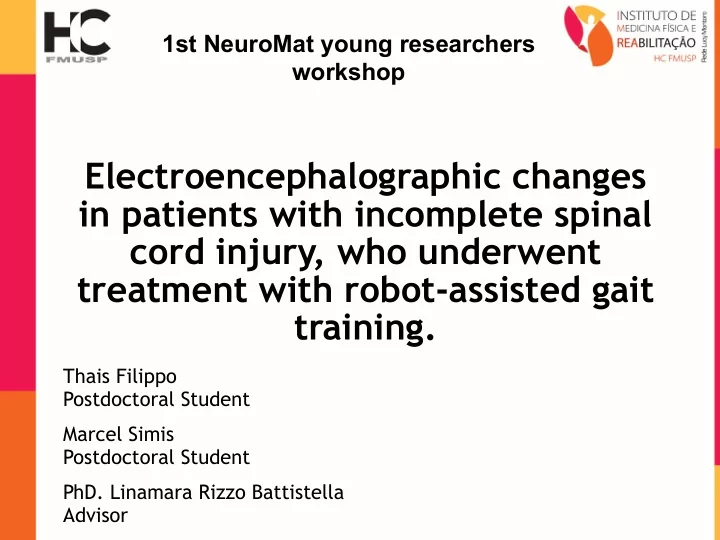

1st NeuroMat young researchers workshop Electroencephalographic changes in patients with incomplete spinal cord injury, who underwent treatment with robot-assisted gait training. Thais Filippo Postdoctoral Student Marcel Simis Postdoctoral Student PhD. Linamara Rizzo Battistella Advisor
Introduction • A common focus during rehabilitation after spinal cord injury (SCI) is on promoting improvements in functional walking capacity. � • Robot-assisted gait training (RAGT) is a therapeutic intervention that can improve walking ability in patients with SCI.
Introduction • Experimental and clinical studies have demonstrated that structural and functional plasticity occurs in the adult nervous system in response to spinal cord injury. � • These plasticity changes occur at multiple levels: cortical, subcortical, brainstem, and spinal cord.
Introduction • The process of plasticity consists of changes in the activation pattern either of structure or function that involves alteration of the strength of existing connections and sprouting of new neural connections. � • Reorganization of cortical representation occurs after CNS injuries such as stroke or SCI, which may account for recovery of function after injury. �
AIM • The purpose of this study was to assess gait function and electroencephalography in SCI patients that underwent treatment with RAGT
Methods Conditions: patients with incomplete spinal cord injury ASIA C or D with injury time between 1-36 months, above 16 years and below 60 years, admitted to the Institute of Physical Medicine and Rehabilitation /Lucy Montoro Rehabilitation Institute Lokomat: • Fifteen SCI subjects participated in 30-minute sessions 5 times weekly for 6 weeks. • Patients underwent training with gradual increase in load and speed, according to the tolerance of each patient. • The body support started at 50 % of the patient body weight, with progressive load increase of 10% of the patient body weight every 2 weeks. • The progression of speed was accompanied during the training period.
Lokomat Lokomat, a robot-assisted gait training system, consisted of robotic gait orthosis, body weight support and treadmill.
Methods Walking capacity and balance was assessed by the: • Walking Index for Spinal Cord Injury II (WISCI II), • 10 Meter Walking Test (10MWT), • Six-Minute Walk Test (6MWT), Before and after • Berg Balance Scale (BBS) training. • Time Up and Go (TUG), � • A 128 channels electroencephalogram (EEG) was used to record the rest state activity before and after intervention. � ⟾ Data analyses: Wilcoxon signed-rank test.
Results • At the end of rehabilitation, the group showed a significant improvement in the score WISCI II, 6 MWT, BBS and TUG (P<0.01). � Lokomat (n=15) Pre Post p-value WISCI-II 9.4 11.26 p = 0.0090 6MWT 137.85 194.4 p= 0.0284 10MWT 39.98 30.64 p= 0.0926 TUG 52.12 40.62 p= 0.0367 BBS 24.93 29 p=0.0075
Results � EEG: The ratio of the spectral potentials of the alpha and theta bands measure at the baseline was correlated with the improvement of motor function. Besides, changes in alpha theta ratio was correlated with motor function improvement.
Conclusions � • The data suggest that the combined programme RAGT + Inpatient induces improvements in gait pattern and balance in SCI. � • Index of alpha theta ratio measure by EEG, may be a prognostic biomarker for SCI patients, however further studies are necessary.
Limitation • EEG was used to record the rest state.
Future Activities • Investigate the neurophysiological predictors of response to treatment. • Analyze the neurophysiological effects of treatment with HD-tDCS to the Lokomat gait training. • TMS analysis to verify the integrity of the corticospinal tract. • Gait training with the NEARS +EEG for analysis of brain metabolism.
Recommend
More recommend